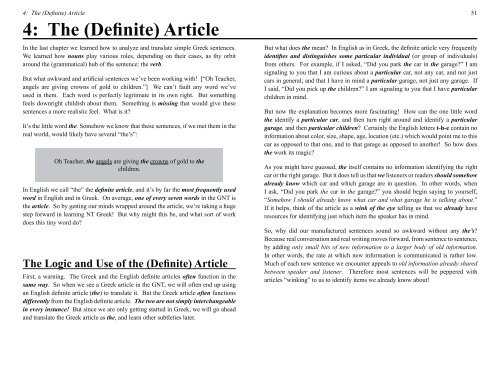Elementary New Testament Greek, 2014a
Elementary New Testament Greek, 2014a
Elementary New Testament Greek, 2014a
Create successful ePaper yourself
Turn your PDF publications into a flip-book with our unique Google optimized e-Paper software.
4: The (Denite) Article<br />
4: The (Denite) Article<br />
In the last chapter we learned how to analyze and translate simple <strong>Greek</strong> sentences.<br />
We learned how nouns play various roles, depending on their cases, as thy orbit<br />
around the (grammatical) hub of the sentence: the verb.<br />
But what awkward and articial sentences we’ve been working with! [“Oh Teacher,<br />
angels are giving crowns of gold to children.”] We can’t fault any word we’ve<br />
used in them. Each word is perfectly legitimate in its own right. But something<br />
feels downright childish about them. Something is missing that would give these<br />
sentences a more realistic feel. What is it?<br />
It’s the little word the. Somehow we know that these sentences, if we met them in the<br />
real world, would likely have several “the’s”:<br />
Oh Teacher, the angels are giving the crowns of gold to the<br />
children.<br />
In English we call “the” the denite article, and it’s by far the most frequently used<br />
word in English and in <strong>Greek</strong>. On average, one of every seven words in the GNT is<br />
the article. So by getting our minds wrapped around the article, we’re taking a huge<br />
step forward in learning NT <strong>Greek</strong>! But why might this be, and what sort of work<br />
does this tiny word do?<br />
The Logic and Use of the (Denite) Article<br />
First, a warning. The <strong>Greek</strong> and the English denite articles often function in the<br />
same way. So when we see a <strong>Greek</strong> article in the GNT, we will often end up using<br />
an English denite article (the) to translate it. But the <strong>Greek</strong> article often functions<br />
differently from the English denite article. The two are not simply interchangeable<br />
in every instance! But since we are only getting started in <strong>Greek</strong>, we will go ahead<br />
and translate the <strong>Greek</strong> article as the, and learn other subtleties later.<br />
But what does the mean? In English as in <strong>Greek</strong>, the denite article very frequently<br />
identies and distinguishes some particular individual (or group of individuals)<br />
from others. For example, if I asked, “Did you park the car in the garage?” I am<br />
signaling to you that I am curious about a particular car, not any car, and not just<br />
cars in general; and that I have in mind a particular garage, not just any garage. If<br />
I said, “Did you pick up the children?” I am signaling to you that I have particular<br />
children in mind.<br />
But now the explanation becomes more fascinating! How can the one little word<br />
the identify a particular car, and then turn right around and identify a particular<br />
garage, and then particular children? Certainly the English letters t-h-e contain no<br />
information about color, size, shape, age, location (etc.) which would point me to this<br />
car as opposed to that one, and to that garage as opposed to another! So how does<br />
the work its magic?<br />
As you might have guessed, the itself contains no information identifying the right<br />
car or the right garage. But it does tell us that we listeners or readers should somehow<br />
already know which car and which garage are in question. In other words, when<br />
I ask, “Did you park the car in the garage?” you should begin saying to yourself,<br />
“Somehow I should already know what car and what garage he is talking about.”<br />
If it helps, think of the article as a wink of the eye telling us that we already have<br />
resources for identifying just which item the speaker has in mind.<br />
So, why did our manufactured sentences sound so awkward without any the’s?<br />
Because real conversation and real writing moves forward, from sentence to sentence,<br />
by adding only small bits of new information to a larger body of old information.<br />
In other words, the rate at which new information is communicated is rather low.<br />
Much of each new sentence we encounter appeals to old information already shared<br />
between speaker and listener. Therefore most sentences will be peppered with<br />
articles “winking” to us to identify items we already know about!<br />
51


















